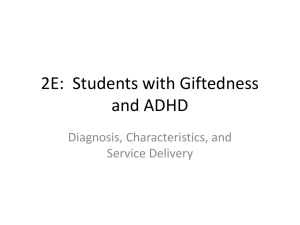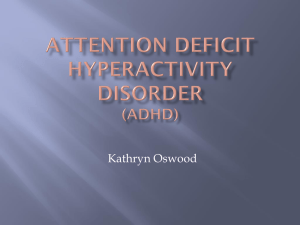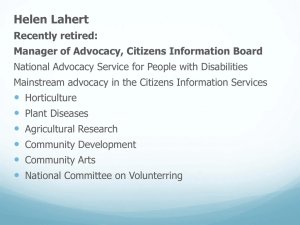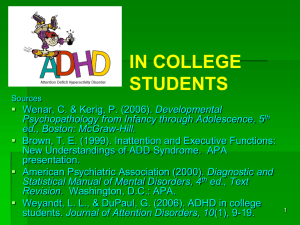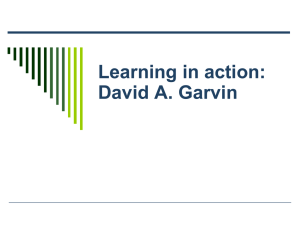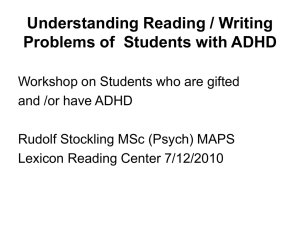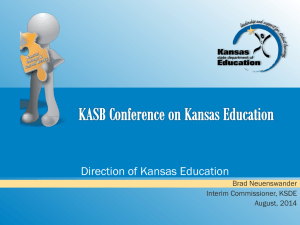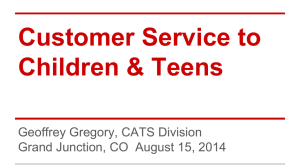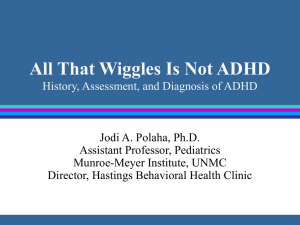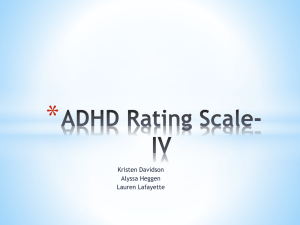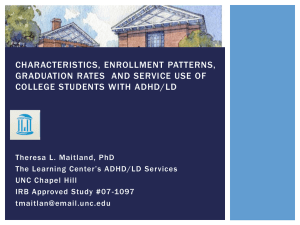Ready for Take-Off: Preparing Teens with ADHD/LD for College
advertisement
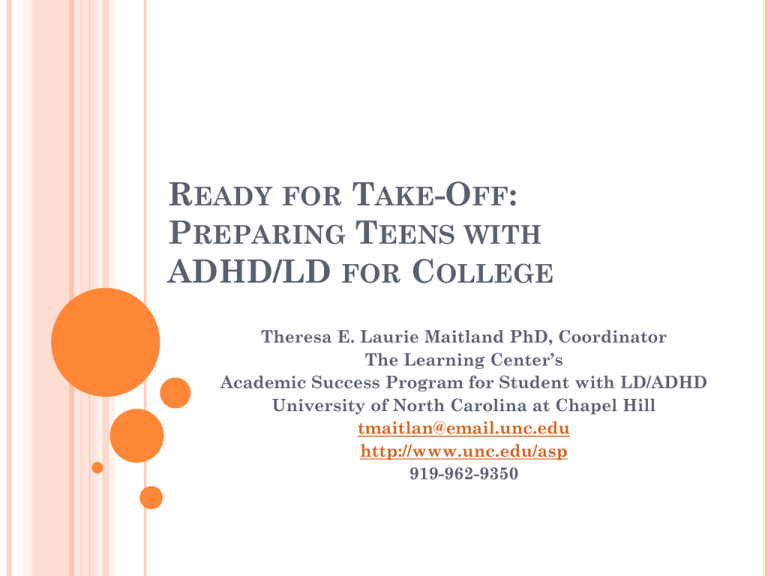
READY FOR TAKE-OFF: PREPARING TEENS WITH ADHD/LD FOR COLLEGE Theresa E. Laurie Maitland PhD, Coordinator The Learning Center’s Academic Success Program for Student with LD/ADHD University of North Carolina at Chapel Hill tmaitlan@email.unc.edu http://www.unc.edu/asp 919-962-9350 WE WILL DISCUSS: College experiences of students with LD/ADHD Factors that may lead to transition challenges How adults might be part of the problem How adults can become part of the solution How to better prepare teens with ADHD/LD for college transition GOOD NEWS FOR COLLEGE STUDENTS WITH ADHD/LD Number has mushroomed in recent years Tenfold increase since the late 1970s More than doubled since the 1990s; from 1% to 2.4% Make up the largest percentage of disabled students on 4 year college campuses 4%-6% of college population References: ETS, 2007, NCES, 2000, Henderson, 2001, McKee, T. 2008 NOT SO GOOD NEWS FOR COLLEGE STUDENTS WITH ADHD/LD… A fraction (47%) of students enrolled in LD classes go on to a postsecondary setting 15.9% of these students attend 4 year colleges Postsecondary attendance rates for disabled students is nearly 20% less than non-disabled peers References: (NLTS2, 2009) HARD TRUTH FOR ALL STUDENTS: GETTING INTO COLLEGE IS ONLY HALF THE BATTLE… National Statistics: Five years after starting college: Non-disabled students: 55%-64% were still enrolled or had graduated Disabled: 52% were still enrolled or had graduated Graduation from postsecondary setting has a significant impact on adult life References: NCES, 1999, 2000 and 2003, U.S. Census Bureau, 2002; Porter, 2002); Tagayuna et. Al., 2005 MORE GOOD NEWS FOR COLLEGE STUDENTS WITH ADHD/LD… They may graduate at the same rate as their non-disabled peers if they access support. Vogel and Adelman (1990, 2000) Vogel et al. (1998, 1999). Dawson College in Canada (Jorgenson et al., 2003) MORE NOT SO GOOD NEWS ABOUT COLLEGE STUDENTS WITH DISABILITIES… Only a third (1/3) of the college students who received special education services in high school sought formal accommodations in college Not all of these student used available resources References: Newman et al. (2009) NLTS2 MORE NOT SO GOOD NEWS FOR ALL COLLEGE STUDENTS… • • 50% of college students may need to seek help for emotional/social issues This fall’s college freshmen reported all time lows for emotional health; • 48.1% did not rate emotional health as good/above average References: Kadison, R. , and DiGeronimo, T. (2004). ; Sieben, L. (2011). WHAT WE KNOW ABOUT THE EXPERIENCES OF COLLEGE STUDENTS WITH ADHD/LD… They are likely to : Have lower grade point averages Be placed on probation more often Take longer to graduate Graduate at even lower rates than students with other disabilities Struggle more with necessary coping and self management skills References: Barkley, Murphy, & Fischer, 2007; D’Amico, personal communication, January 29, 2008; Heiligenstein, Guenther, Levey, Savino, & Fulwiler, 1999; Murray, Goldstein, Nourse, & Edgar, 2000; National Center for Education Statistics, 2003; Newman, Wagner, Cameto, & Knokey, 2009; Rabiner, Anastopoulos, Costello, Hoyle, & Swartzwelder, 2008; Reaser et al. 2007; Vogel & Adelman, 1990a, 1990b, 2000; Vogel et al., 1998; Vogel, Leyser, Wyland, & Brulle, 1999; Wagner, Newman, Cameto, Garza, & Levine, 2005 THE EXPERTS SPEAK Survey 26 students How challenging was your transition to college? 87% somewhat to very challenging. 13% rated it not very challenging Why not challenging? Rigorous demands in high school, practiced advocating, parents slowly let go Why Challenging? Not ready for self advocacy and demands for life management, increased academic expectations. Trouble accepting differences/disability THE EXPERTS SPEAK How has your disability impacted your adjustment to college? WHY IS THE TRANSITION TO COLLEGE CHALLENGING? College life is dramatically different than high school. Total freedom/responsibility No adults The academic expectations are more challenging than those in high school. These differences are at odds with the common problems students diagnosed with ADHD/LD have. Different laws/services THE EXPERTS SPEAK Advice for parents THE EXPERTS SPEAK Advice for educators THE EXPERTS SPEAK Advice for teens WHAT CAN WE DO? Individual interactions: o Assess our expectations and ways of responding o Are we part of the problem? Within our families and schools: Increase expectations to match what college life will expect Develop strategic plans to promote readiness Raise awareness of differences between high school and college TRANSITION REQUIRES ADULTS TO RESPOND IN NEW WAYS Traditional roles: o Authority, Teacher, Fixer, Protector, Director, Advocate o May limit growth in executive functioning and self determination skills o Can be enabling for teens Deliberately adopt new roles: o A coaching, advising or mentoring approach o Targeted to promote executive functioning skills: self understanding, problem solving and decision making o Will be empowering A COACHING APPROACH Features of coaching vs. traditional roles Partnership; teen pilots, adults as co-pilots Teens are the experts; in charge View teens as “naturally, creative, resourceful” View failure/struggles/ challenges as opportunities for growth Adults aren’t “in the game” stay on the sidelines; COACHING SKILLS Explicitly design the goals, the plan including the adult’s role in it: Ask open ended question, that promote reflection; model thinking process Listen and summarize or acknowledge feelings-not fixing or solving Offer suggestions with no attachment Allow consequences to happen, learn from them Accountability AN EXAMPLE Tom comes to you and asks you to talk to his history teacher for him. Apparently he has not completed a paper that is due tomorrow and since his IEP allows for extensions he is asking you to request an extension. Examples of an enabling response? Examples of an empowering response or a coaching approach? COACHING RESPONSE VERSUS ENABLING What would you do? It is the Sunday after a long weekend and Rachael just remembers that she was supposed to have a poster created for her science class, she begs you to let her miss school tomorrow and run to Wal-Mart to get the supplies she needs. What are some enabling responses? What are some empowering/ coaching responses? HOW TO BETTER PREPARE TEENS WITH ADHD/LD FOR TAKE-OFF? Collaborative approach necessary Raise awareness of stark differences between high school and college Challenge teens to “stretch and grow” Assess student’s readiness for college (see checklists in : Ready for Take-off and On Your Own) HOW TO BETTER PREPARE TEENS WITH ADHD/LD FOR TAKE-OFF? o Strategically promote important non-academic readiness skills: self determination o daily living o Teach study skills/strategies that will be necessary in college Slowly fade reliance on accommodations that are not likely to be available at college Promote good decision making during the college application process If more is going on: get help now Q &A RESOURCES: Transition/Self Determination Brinkerhoff, L. ( 2010) College Planning for Students with Learning Disabilities: Retrieved April 23, 2010, from http://www.greatschools.org/LD/school-learning/collegeplanning.gs?content=913 National Center on Secondary Education and Transition http://www.ncset.org/. Burgstahler, Sheryl. DO-IT: Helping Students With Disabilities Transition to College and Careers: Research to Practice Brief Improving Secondary Education and Transition Services through Research September 2003 • Vol. 2, Issue 3 retrieved October 20, 2010 from http://www.ncset.org/publications/viewdesc.asp?id=1168. Bremer, C.D., Kachgal, M., and Schoeller, K. Self-Determination: Supporting Successful Transition Improving Secondary Education and Transition Services through Research. Research to Practice Brief April 2003 • Vol. 2, Issue 1. Retrieved October 20, 2010 from http://www.ncset.org/publications/viewdesc.asp?id=962. Field, S., Martin, J., Miller, R., Ward, M., & Wehmeyer, M. (1998). A practical guide for teaching self-determination. Arlington, VA: Council for Exceptional Children. RESOURCES: Transition/Self Determination Hoffman, A. & Field, S. (2006). Steps to SelfDetermination. Austin, TX: ProEd. Maitland, T., & Quinn, P. (2011). Ready for TakeOff: Preparing Teens with ADHD or LD for College. Washington, D.C. : American Psychological Association ; Magination Press. Quinn, P., & Maitland, T. (2011). On Your Own: A College Readiness Guide for Teens with ADHD or LD. Manuscript submitted for publication. Washington, D.C. American Psychological Association: Magination Press. RESOURCES: Study Skills Mooney, J. and Cole,D. (2000). Learning Outside the Lines. New York, NY: Fireside. Nist, Sherrie, L. and Holschuh, Jodi (2000). Active Learning: Strategies for College Success. Needham Heights, NY: Allyn & Bacon. Paulk, Walter and Owens, Ross, J. Q. (2007). How to Study in College 10th Edition. Boston, MA: Houghton Mifflin. Free download: http://the-manuals.com/how-to-study-in-college-walterpaulk-manual/. Strichart, S.S. and Magrum II, C., T. (2002) Teaching Learning Strategies and Study Skills to Students with Learning Disabilities, Attention Defict Disorders or Special Needs, Third Edition. Boston, MA: Allyn and Bacon. Walter,T.L., Siebert, A., and Smith, L. N. (2000) Student Success: How to Succeed in College and Still Have Time for Your Friends. Orlando, FL: Harcourt Brace & Company. RESOURCES: BOOKS 1 Barkin, C. (1999). When Your Kid Goes To College: A Parent's Survival Guide. New York. New York: Avon Books. Beattie, Melody Codependent No More: How to Stop Controlling and Start Caring for Yourself. MN: Hazelden, 1987. Coburn, K., & Treeger, M. (2003). Letting Go: A Parents' Guide To Understanding The College Years, 4*** Edition. New York, New York: HarperCollins. Johnson, H., & Schelhas-Miller, C. (2000). Don't Tell Me What to Do. Just Send Money. New York, NY: St. Martin's Griffin. Kastner, L., & Wyatt, J. (2002). The Launching Years: Strategies for Parenting from Senior Year to College Life. New York, NY: Three Rivers Press. Kadison, Richard , and DiGeronimo, Theresa Foy. (2004). College of the Overwhelmed: The Camus Mental Health Crisis and What To Do About It. San Francisco, CA : Jossey-Bass. Maitland, T., & Quinn, P. (2011). Ready for Take-Off: Preparing Teens with ADHD or LD for College. Washington, D.C. : American Psychological Association ; Magination Press. RESOURCES : BOOKS o 2 Mullendore, R., & Hatch, C. (2000). Helping Your First-Year College Student Succeed: A Guide For Parents.. Columbia, SC: University of South Carolina, National Resource Center For The First Year Experience and Students in Transition. Pasick, P. (1998). Almost Grown: Launching Your Child From High School To College. New York, New York: W.W. Norton and Company. Parenting for Prevention: How to stop enabling and start empowering kids. MN: Johnston Institute, Hazelton, 1997. Quinn, P., Ratey, N., & Maitland, T. (2000). Coaching College Students with AD/HD: Issues and Answers. Silver Spring, MD: Advantage Books. Quinn, P., & Maitland, T. (2011). On Your Own: A College Readiness Guide for Teens with ADHD or LD. Manuscript submitted for publication. Washington, D.C. American Psychological Association: Magination Press. Sleeper-Triplett, J. (2010). Empowering Youth with ADHD: Your guide to coaching adolescents and young adults. Plantation Florida: Specialty Press. REFERENCES 1 Barkley, R. A., Murphy, K. R., & Fischer, M. (2007). Adults with ADHD: Clinic-referred cases vs. children grown up. ADHD Report, 15(5), 1-7, 13. Cortiella, C. (2009, June 8). The state of learning disabilities. New York, NY: National Center for Learning Disabilities. Retrieved from http://www.ncld.org/stateofld. DeBerard, M. S., Spielmans, G. I., & Julka, D. L. (2004). Predictors of academic achievement and retention among college freshmen: A longitudinal study. College Student Journal, 38, 6680. Gerber, P. J., Reiff, H. B., & Ginsberg, P. (1996). Reframing the learning disabilities experience. Journal of Learning Disabilities, 29, 98-101. Heiligenstein, E., Guenther, G., Levey, A., Savino, F., & Fulwiler, J. (1999). Psychological and academic functioning in college students with attention deficit hyperactivity disorder. Journal of American College Health, 47, 181-185. REFERENCES o o 2 Kuh, G., Kinzie, J., Schuh, J., Whitt, E., & Associates. (2005). Student success in college: Creating conditions that matter. San Francisco, CA: Jossey-Bass. Mattson, C. E. (2007). Beyond admission: Understanding precollege variables and the success of at-risk students. Journal of College Admissions, 196, 8-13. MckKee, T. (2008). Comparison of a norm-based versus a criterion-based approach to measuring ADHD symptomatolgy in college students. Journal of Attention Disorders, 11(6), 677-688. Murray, C., Goldstein, D., Nourse, S., & Edgar, E. (2000). The postsecondary school attendance and completion rates of high school graduates with LD. Learning Disabilities Research and Practice, 15, 119-127. National Center for Education Statistics. (2000). Postsecondary students with disabilities: Enrollment, services and persistence (NCES 2000-092). Washington, DC: U.S. Department of Education. Retrieved from http://nces.ed.gov/pubs2000/2000092.pdf. References • 3 National Center for Education Statistics. (2003). CD-ROM: Beginning postsecondary students longitudinal study: Second follow-up Data Analysis System (DAS) BPS:96/01 (Tables on degree attainment and persistence of 199596 beginning postsecondary students in 2001 by disability status and learning disability status). Washington, DC: U.S. Department of Education. Retrieved from http://nces.ed.gov/pubsearch/pubsinfo.asp?pubid=2003159. Newman, L., Wagner, M., Cameto, R., & Knokey, A. M. (2009). The posthigh school outcomes of youth with disabilities up to 4 years after high school: A report from the National Longitudinal Transition Study 2 (NLTS2) (NCSER 2009-3017). Retrieved February 19, 2009, from www.nlts2.org/reports/2009_04/nlts2_report_2009_04_complete.pdf. Porter, K. (2002). The value of a college degree. Retrieved October 14, 2007, from http://www.ericdigest.org/2003-3/value.htm. Rabiner, D., Anastopoulos, A., Costello, J., Hoyle, R., & Swartzwelder, H. (2008). Adjustment to college in students with ADHD. Journal of Attention Disorders, 11, 689-699. Reaser, A., Prevatt, F., Petscher, Y., & Proctor, B. (2007). The learning and study strategies of college students with ADHD. Psychology in the Schools, 44(6), 627-638. References 4 Ridgell, S. D., & Lounsbury, J. W. (2004). Predicting academic success: General intelligence, “Big Five” personality traits, and work drive. College Student Journal, 38, 607-618. Sieben, L. (2011). “College Freshmen Report Record-Low Levels of Emotional Health.” The Chronicle of Higher Education. January 27, 2011. Tagayuna, A., Stodden, R.A., Change, C., Zeleznik, M.E., & Whelley, T.A., (2005). A two-year comparison of support provision for persons with disabilities in postsecondary education. Journal of Vocational Rehabilitation, 22 (1), 13-21. U.S. Census Bureau. (2002). The big pay-off: Educational attainment and synthetic estimates of work-life earnings. (Current Population Reports, Special Studies, P23-210). Washington, DC: Commerce Dept., Economics and Statistics Administration, Census Bureau. Retrieved October 14, 2007, from http://www.census.gov/prod/2002pubs/p23-210.pdf. U.S. Department of Education, National Center for Education Statistics (2000). Postsecondary Students with Disabilities: Enrollment, Services and Persistence. NCES 2000-092. Retrieved March 25, 2010 from http://nces.ed.gov/pubs2000/2000092.pdf. REFERENCES 5 U.S. Department of Education. National Center for Education Statistics(2002). Descriptive Summary of 1995–96 Beginning Postsecondary Students: Six Years Later, NCES 2003–151, by Lutz Berkner, Shirley He, and Emily Forrest Cataldi. Project Officer: Paula Knepper. Washington, DC. U.S. Department of Education National Center for Education Statistics. Beginning Postsecondary Students Longitudinal Study Second Follow-up BPS:96/01. Tables on Degree Attainment and Persistence of 1995-96 Beginning Postsecondary Students in 2001 by Disability Status and Learning Disability Status. Email from Aurora D’Amico: January 29, 2008. http://nces.ed.gov/pubsearch/pubsinfo.asp?pubid=2003159. United States Government Accountability Office Report (October 2009) Higher Education and Disability. GAO-10-33 . website: http://www.gao.gov/new.items/d1033.pdf. Vogel, S. and Adelman, P. (1990). Extrinsic and intrinsic factors in graduation and academic failure among LD college students. Annals of Dyslexia(Orton Dyslexia Society), 40, 119-137. REFERENCES 6 Vogel, S. and Adelman, P. (1990). Intervention effectiveness at the o postsecondary level for the learning disabled. In T.Scruggs & B. Wong (Eds.) Intervention research in learning disabilities. 329-344. New York: Springer-Verlag. o o o Vogel, S. and Adelman P (2000). “Adults with Learning Disabilities 8-15 years after College, Learning Disabilities: A Multidisciplinary Journal, 10 (3) 165-182. Vogel, S., Leonard, F., Scales, W., Hayeslip, P, Hermansen, J., & Donnells, L. (1998). The national learning disabilities postsecondary data bank: An overview. Journal of Learning Disabilities, 31, 234-247. Vogel, S., Leyser, Y., Wyland, S. & Brulle, A. (1999). Students with learning disabilities in higher education: Faculty attitudes and practices. Learning disabilities Research & Practice, 14, 173-186. Wagner, M., Newman, L., Cameto, R., Garza, N., & Levine, P. (2005). After high school: A first look at the post school experiences of youth with disabilities: A report from the national longitudinal transition study-2 (NLTS2). ). Retrieved May 16, 2008 from: http://eric.ed.gov/ERICDocs/data/ericdocs2sql/content_storage_01/0000019 b/80/27/fb/9d.pdf.


